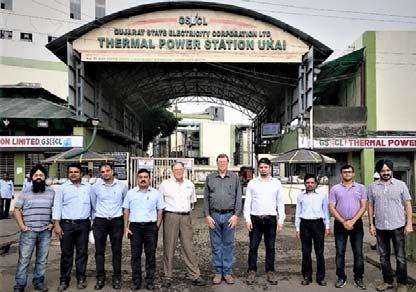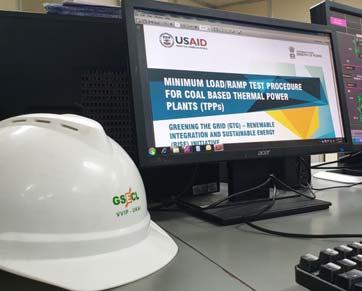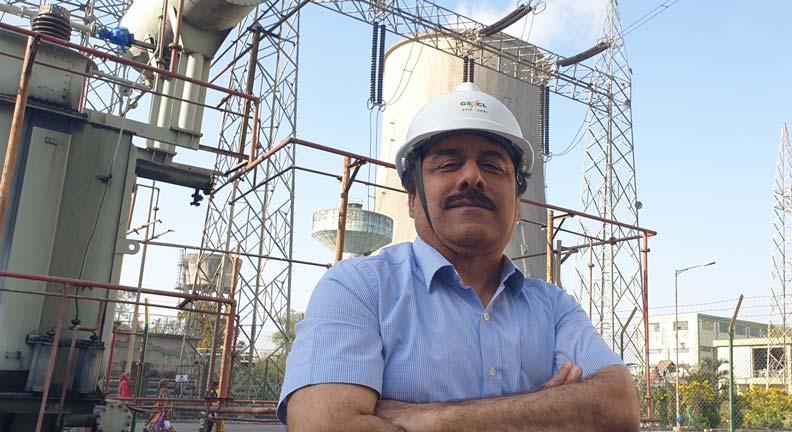
3 minute read
Empowering the Future
USAID India’s Greening the Grid program aims to support integration of largescale, variable renewable energy into India’s existing power grid.
By Paromita Pain
Advertisement
In 2018, BP’s Statistical Review of World Energy report pegged India’s energy consumption at 809.2 million tons of oil equivalent. The country’s energy consumption is behind only the United States and China. India generates about 9 percent of its electricity from renewable resources and plans to deploy unprecedented levels of renewable energy on its power grid, which can greatly reduce the economy’s carbon intensity and strengthen energy security. Greening the Grid-Renewable Integration and Sustainable Energy (GTG-RISE) can play a crucial role in helping India meet its renewable energy targets by “integrating large-scale, variable renewable energy into the existing power grid.” GTG-RISE is a five-year program of the United States Agency for International Development (USAID) India, implemented in partnership with the Government of India’s Ministry of Power, under the Asia EDGE (Enhancing Development and Growth through Energy) initiative of the U.S. government.
Meeting energy targets
“India has set a target for adding 175 gigawatts of renewable energy to its energy portfolio by 2022,” says Monali Zeya Hazra, regional program manager for USAID India. “GTG is about testing solutions and technologies for integrating renewable energy into the main power grid that feeds the country. Due to the variable nature of renewable energy resources, important challenges lie ahead, in ensuring grid stability and frequency to maintain uniform power supply.”
The GTG-RISE program seeks to address important grid flexibility-related issues, through detailed analysis of how grids can handle different technical options, and demonstrate some of the technologies specific to Indian conditions through pilot projects and sharing knowledge of best practices.
Studies and pilots
The first detailed modeling was done in 2017 with the Power System Operation Corporation Limited, a Government of India enterprise under the Ministry of Power, and the National Renewable Energy Laboratory, a U.S.-based Department of Energy lab. “That report focused on different issues like how India doesn’t have adequate cheaper gas power and, thus, could look at making the coal plants more flexible in terms of generating more power and reducing power production when required,” says Hazra. “Implementing such changes requires advanced technical adjustments.”
The report emphasized that integration of renewable energy is achievable based on projected power system plans and regulations, and that this level of renewable energy offers benefits of fuel savings and reduced emissions, while still fully meeting projected demand for electricity. “This was an extremely consultative study,” says Hazra, “and the intent was to enhance the capacity of stakeholders.”

Above and below: With support from USAID India, the Gujarat State Electricity Corporation Limited successfully operated its 500 MW Ukai unit at only 40 percent of its capacity during a recently conducted low-load test run. These low-load test runs allow GSECL to identify its ability and adaptability to reduce its generation when asked by the system operator, for integrating more renewable energy, and remain synchronized with the power grid.
Photographs courtesy B.A. Gandhi

The next stage was to conduct pilot studies to validate findings as well as look for solutions to different issues like the type of battery that would work best as storage units. Post that, knowledge-sharing workshops for replicating and scaling technologies were organized and six pilot projects are being implemented.
One of these pilot projects was with the Gujarat State Electricity Corporation Limited (GSECL). “Over the last four years, USAID India’s GTG-RISE initiative has immensely helped GSECL in ascertaining the techno-commercial feasibility of the conventional coal-based units in order to address faster ramp up and ramp down of operations and lower technical minimums in light of the existing procedures, equipment, processes and operational practices,” says B. A. Gandhi, executive engineer (efficiency), GSECL.

B. A. Gandhi, executive engineer (efficiency) at Gujarat State Electricity Corporation Limited (GSECL).
Courtesy B.A. Gandhi
The pilot project enabled GSECL to identify techno-economic viability of a range of feasible, power plant-specific options for achieving the desired levels of flexibility as well as identify changes that pertain to aspects related to fuel cycles, water and steam cycles, control systems and capacity building of operational and maintenance teams, among other areas, within the power plant.
Regional energy security
Another important aspect that the collaboration addresses pertains to regional energy security in South Asia. A bigger grid integrated with neighboring countries provides options for more flexible resources. In turn, these countries gain access to the more cost-effective renewable energy produced by India. In South Asia, India, Bangladesh, Bhutan and Nepal have established transmission links through which electricity is being traded. “USAID has the SARI/EI [South Asia Regional Initiative for Energy Integration] program that supports regional integration,” says Hazra. “The whole idea is to strengthen the transmission system that would enable the easy movement of power. If the broader grid can be seamlessly integrated with neighboring countries like Nepal and Bhutan, then through sharing resources, India’s hydro power issues, for example, can be tackled using resources that neighboring countries have.”
Paromita Pain is an assistant professor of Global Media Studies at the University of Nevada, Reno.










